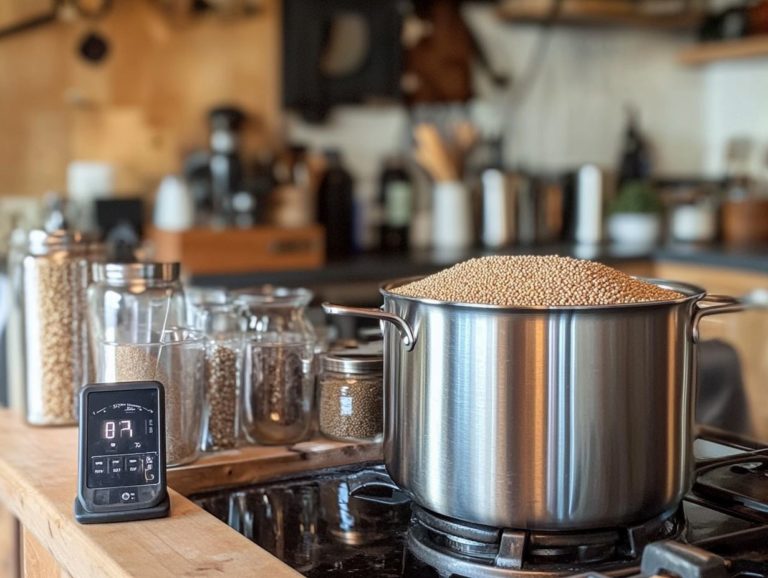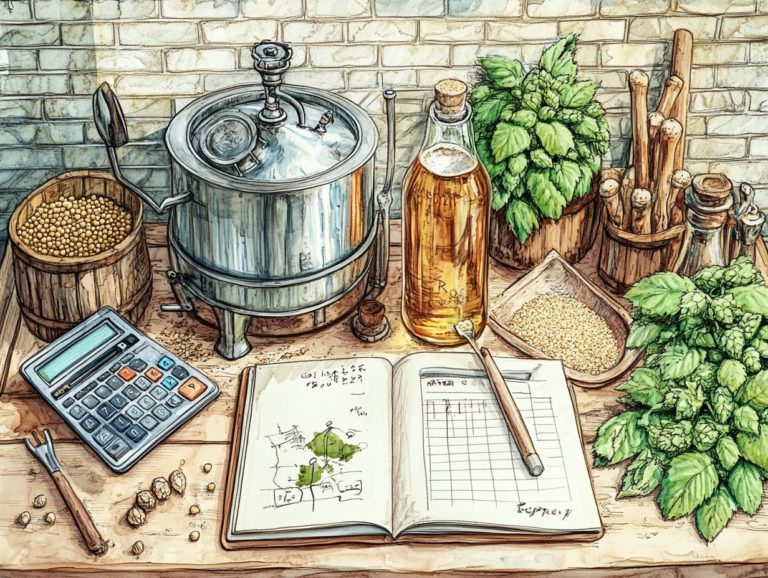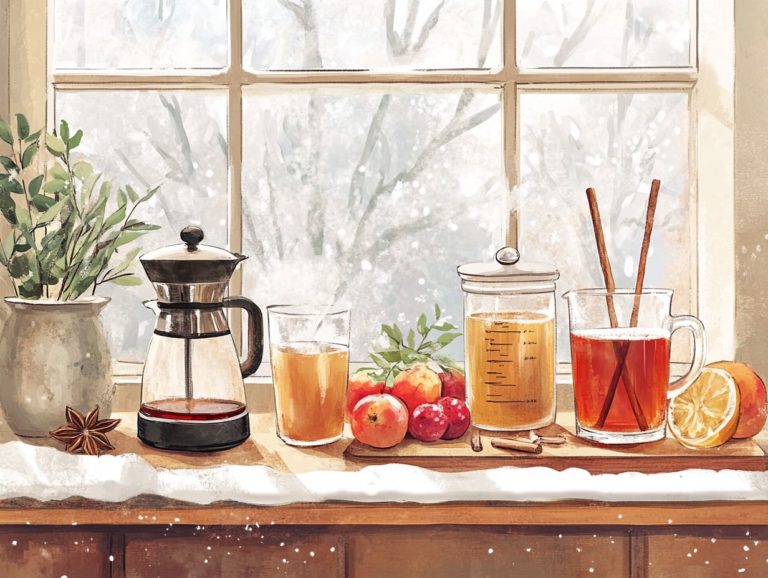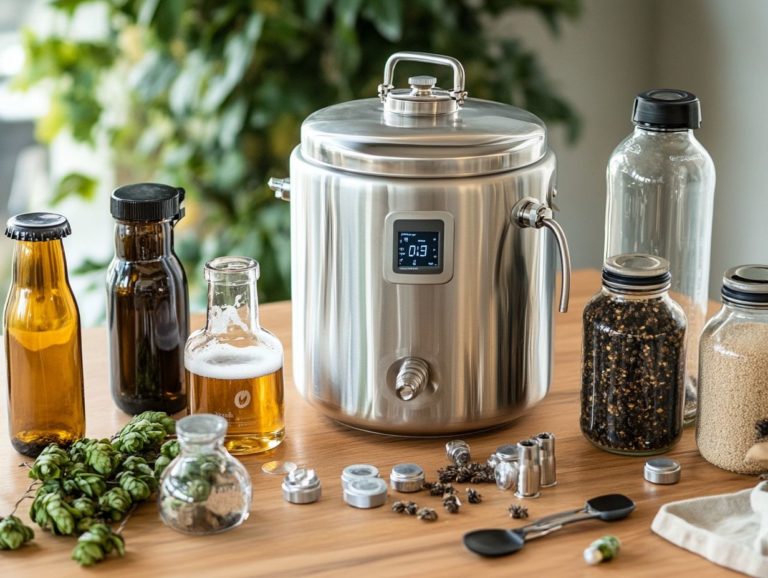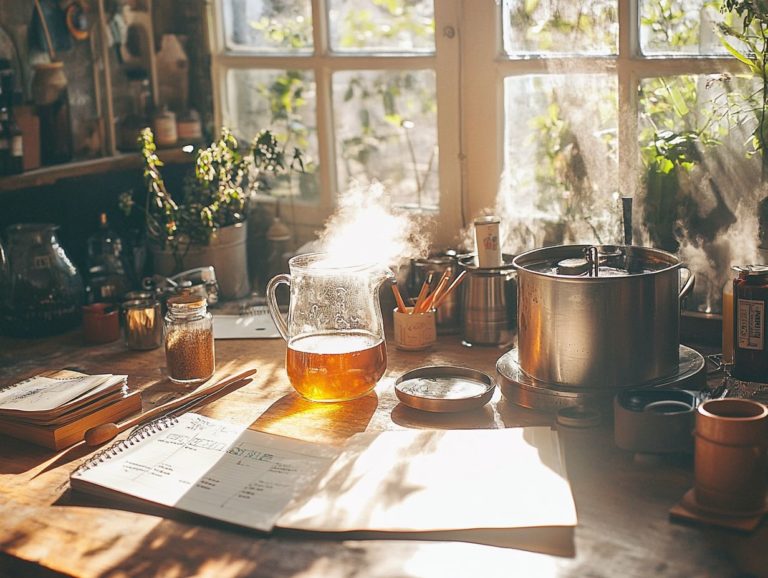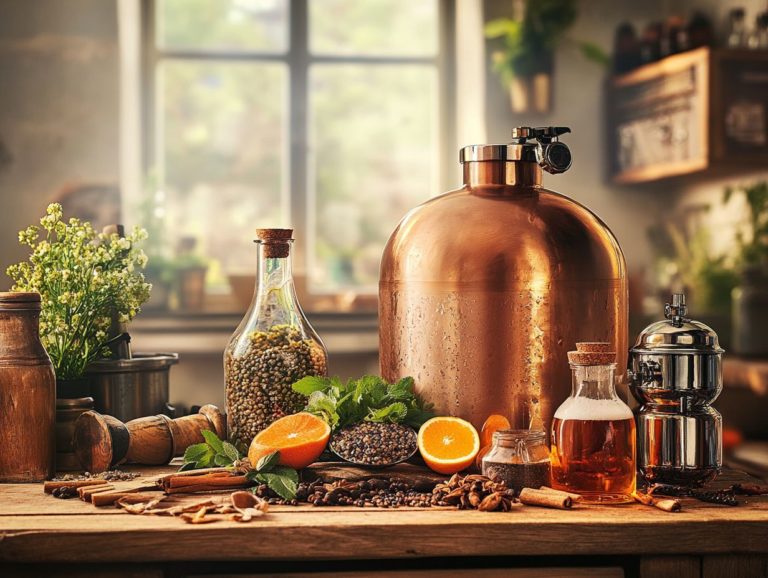Best Temperature Ranges for Brewing Different Beers
Contents
- The Art and Science of Beer Brewing
- Key Takeaways:
- Understanding the Brewing Process: From Grain to Glass
- Exploring the World of Beer
- How Temperature Affects the Brewing Process
- Temperature Ranges for Different Beer Styles
- Best Temperatures for Ales and Pale Ales
- What are the Best Temperatures for Lagers?
- What are the Best Temperatures for Stouts and Porters?
- What are the Best Temperatures for Pilsners?
- What are the Best Temperatures for Wheat Beers?
- What Are the Best Temperatures for Sour Beers?
- Tips for Controlling Temperature During Brewing
- What Equipment Is Needed to Control Temperature?
- What Are the Best Practices for Controlling Temperature in Brewing?
- What are the Common Mistakes to Avoid in Temperature Control?
- Frequently Asked Questions for Brewing and Serving Beer
- What are the benefits of brewing beer at specific temperature ranges?
- What is the best temperature range for brewing ales?
- Can I brew lagers at the same temperature range as ales?
- What happens if I brew ales at a lower temperature range?
- How does temperature affect the different stages of the brewing process?
- What is the ideal temperature for storing and serving beer?
The Art and Science of Beer Brewing
Beer brewing is a delightful blend of art and science, where mastering the balance of ingredients and techniques can lead you to craft a truly refreshing beverage. The nuances of brewing, from selecting the right hops to controlling the fermentation temperature, make it an enjoyable experience for all beer enthusiasts.
By understanding the fundamental aspects of brewing such as essential ingredients and the detailed step-by-step process you lay the groundwork for creating exceptional beer, whether it s a classic lager or a complex IPA.
One of the most pivotal factors influencing your final product is temperature. This guide explains the ideal temperature ranges for brewing various beer styles, explores how temperature impacts fermentation, and provides tips for maintaining optimal conditions throughout the entire process. Whether brewing at home or in professional breweries, understanding temperature control is crucial for success.
Whether you’re just starting your brewing journey or aiming to refine your skills, this information offers valuable insights to elevate your brewing experience. From homebrew setups to advanced temperature management techniques, this guide covers it all.
Key Takeaways:
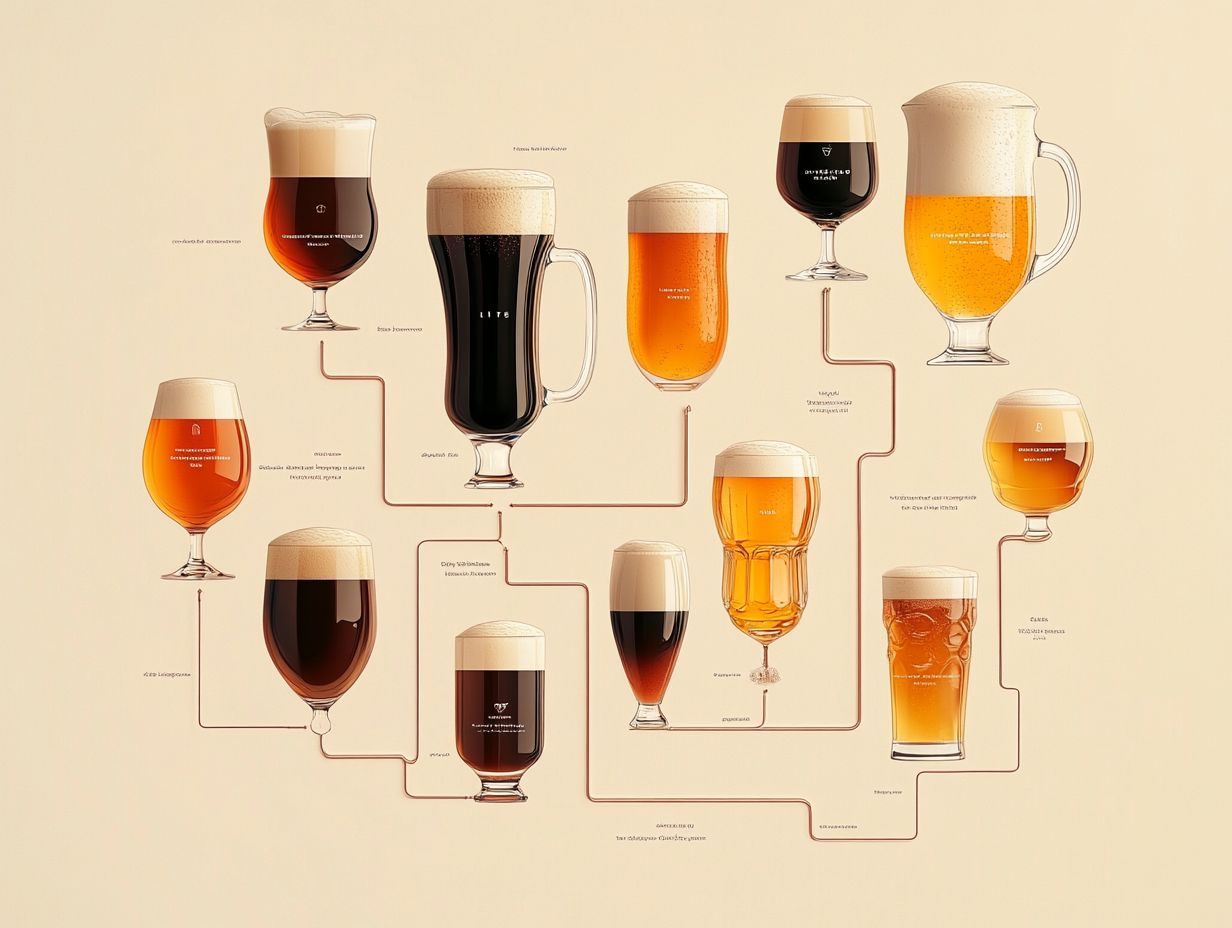
- The ideal temperature for brewing beer is between 65-75 F, but different beer styles require specific temperature ranges for optimal results. Understanding these temperature nuances can significantly enhance your brewing experience, whether at home or in a professional setting.
- Ales should be brewed at a temperature range of 68-72 F, while lagers require a cooler temperature of 45-55 F for fermentation. These recommended temperatures help bring out the best flavor characteristics in each beer style.
- Stouts, porters, pilsners, wheat beers, and sour beers each have their own unique temperature ranges for brewing, ranging from 60-75 F for stouts and porters to 45-50 F for pilsners.
Understanding the Brewing Process: From Grain to Glass
Understanding the brewing process is crucial for any beer enthusiast, as it involves a series of meticulous steps that transform basic ingredients into the aromatic and flavorful beverages you cherish today. Your journey from grain to glass encompasses various techniques and methods, all significantly influenced by temperature, the selection of ingredients like hops and malt, and the desired characteristics of the final product. From the slightly chilled pale ales to the room temperature stouts and porters, the brewing process impacts every type of beer.
Get ready to dive into key concepts such as fermentation, the role of different beer styles, and the importance of temperature control during the brewing process, providing you with a solid foundation whether you re just starting out or you re a seasoned brewer.
What is Beer?
Beer is a fermented beverage crafted from four primary ingredients: water, malted grains, hops, and yeast. Each of these elements plays a crucial role in defining the multitude of beer types and their distinct flavors. From the refreshing taste of lagers to the robust profiles of strong beers like barleywine, the variety in beer styles showcases the breadth of brewing possibilities.
As you explore the world of beer, you’ll encounter several unique categories, each showcasing qualities that cater to a diverse array of tastes. Ales are renowned for their fruity and complex aromas, often presenting a rich mouthfeel that can vary from smooth to slightly bitter. Lagers are crisp and clean, offering a refreshing taste that s particularly delightful on a warm day. Stouts are known for their dark color and rich flavors of coffee and chocolate, resulting in a velvety texture that envelops the palate. Additionally, wheat beers and Belgian ales introduce unique flavor profiles that can range from banana or clove notes to more peppery and fruity characters when brewed with strains like Kveik yeast.
With variations arising from different brewing processes and added ingredients, you ll find an abundance of choices, each boasting its own character and depth. Whether you prefer the hoppiness of an American pale ale or the rich flavors of an amber lager, the craft beer landscape is vast and diverse.
Ready to share your brewing experiences or try out a new recipe? Join the community of beer enthusiasts and embark on your brewing adventure!
Exploring the World of Beer
Beer is one of the oldest and most widely consumed alcoholic beverages in the world. Understanding its basic ingredients and brewing process can deepen your appreciation for this beloved drink.
What are the Basic Ingredients of Beer?
The fundamental ingredients of beer are water, malt, hops, and yeast, each playing a critical role in the brewing process. Together, they significantly shape the final taste and quality of your brew. Understanding how these ingredients interact, especially during fermentation and temperature control, is essential for producing beer with the desired flavor characteristics.
Water is the cornerstone, providing the essential medium for the other ingredients to meld together. Malt, primarily derived from barley, adds sweetness and contributes a fuller body and complex flavors that can range from biscuity to caramel, depending on the type of malt and the roasting process.
Hops are crucial for achieving balance; they counteract the sweetness of the malt by introducing bitterness and various aromatic profiles from floral notes to zesty citrus. This enhances the overall sensory experience of beer, making each sip an adventure for your palate. Proper carbonation levels and the right glassware can elevate the drinking experience, highlighting the beer’s aromas and mouthfeel.
Yeast is essential for fermentation. It transforms sugars into alcohol and carbon dioxide while imparting unique characteristics like fruity esters (a type of flavor compound that adds fruity aromas) or spicy phenols (flavor compounds that add spice-like notes). Together, these ingredients work in unison, creating the rich and diverse world of beer that enthusiasts like you continue to savor and explore. Recommended serving temperatures can also enhance the flavor and aroma profiles of different beer styles, making each tasting experience unique.
What is the Brewing Process?
The brewing process unfolds as a fascinating journey through a series of intricate steps: mashing, boiling, fermenting, and conditioning. Each step plays a vital role in transforming raw ingredients into the delightful beer you relish. From the warmth required during mashing to the cooler temperatures needed for conditioning, every phase is critical in crafting the perfect brew.
It all starts with mashing, where crushed grains mingle with hot water, enabling enzymes to convert starches into fermentable sugars. The temperature during this step is crucial; a lower temperature might yield a drier beer, while a higher one could lead to a sweeter profile.
Once mashing is complete, the wort undergoes boiling, where hops make their grand entrance. The boiling temperature not only extracts bitterness but also shapes the aromatic qualities of your beer. After the boil, the wort cools down and gets pitched with yeast, kicking off the fermentation process. Here, temperature control is essential; warmer fermentation conditions can create fruity esters, while cooler temperatures often lead to cleaner, crisper flavors.
During the conditioning phase, the beer is further refined, developing the complex characteristics that make the finished product enjoyable. Whether it’s a dark beer like a stout or a lighter beer like a pilsner, conditioning allows the flavors to meld and mature, resulting in a well-balanced brew.
How Temperature Affects the Brewing Process
Temperature is truly a game changer in the brewing process, directly impacting fermentation, flavor extraction, and the final characteristics of your beer. Each step of brewing, from mashing to fermentation, requires careful attention to temperature management to achieve the best possible results. Understanding the recommended temperature ranges for different beer styles such as the cooler requirements for lagers and the warmer conditions for ales is essential for producing high-quality brews.
For example, higher temperatures can ramp up bitterness and alcohol content, while cooler temperatures tend to produce smoother, more balanced brews. Getting the temperature right is essential for brewing great beer every degree matters! Grasping how these temperature variations affect the brewing process is crucial for anyone looking to elevate their craft and create exceptional beers that cater to a wide range of tastes.
What is the Ideal Temperature for Brewing Beer?
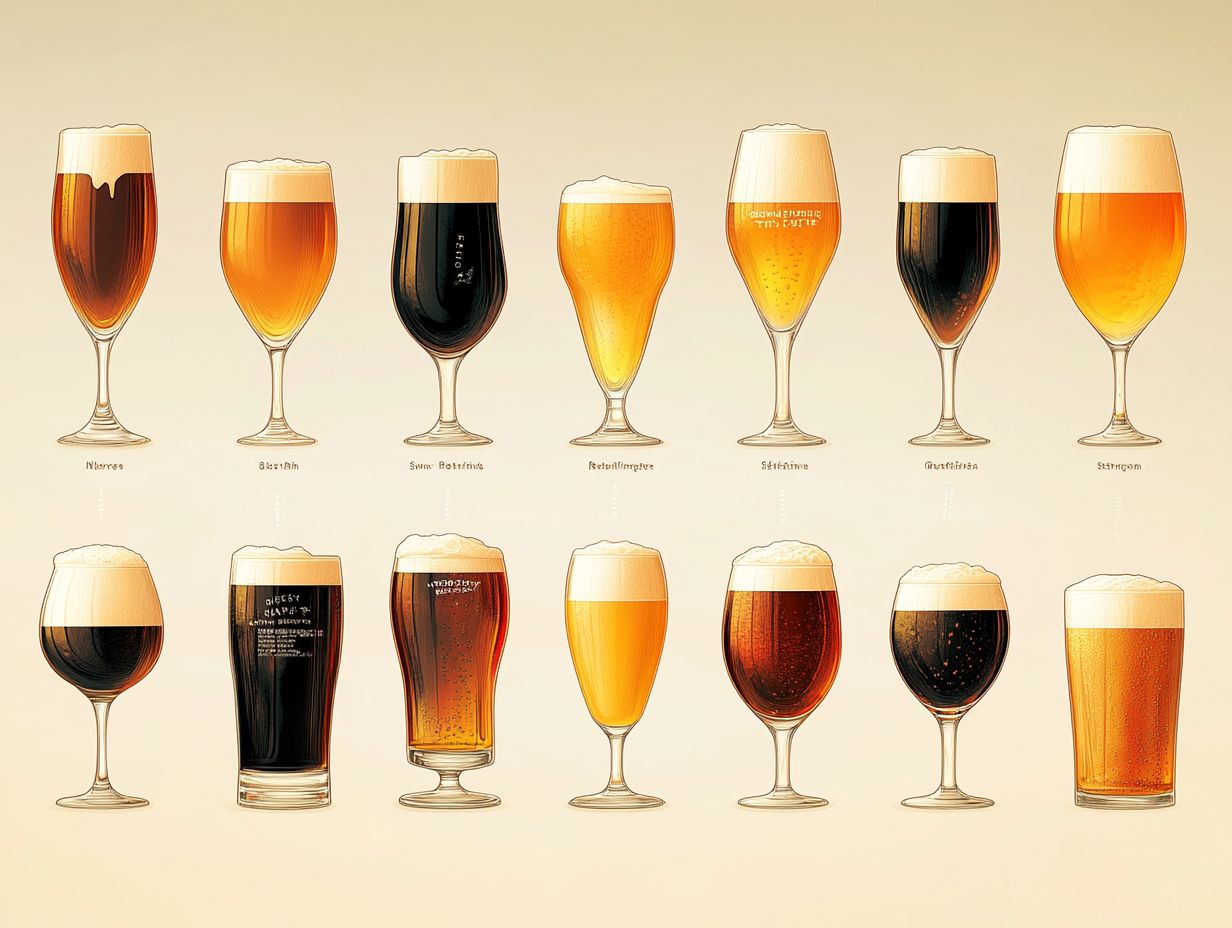
Ales
The ideal temperature for brewing beer isn t a one-size-fits-all scenario; it varies beautifully depending on the style. Ales thrive in the warmer embrace of around 65-75 F.
This temperature difference is vital. It greatly affects the activity of the yeast and the flavor characteristics of the final product. Warmer fermentation temperatures in ales often elevate fruity and estery flavors, resulting in a more aromatic and complex brew.
Lagers
Lagers, on the other hand, prefer the cooler comfort of 45-55 F. Cooler fermentation temperatures foster a clean, crisp profile, allowing subtle malt and hop notes to shine without the distraction of overpowering fruitiness.
Master the art of temperature control during fermentation, as even minor fluctuations can lead to off-flavors or subpar yeast performance. This ultimately affects the quality and consistency of your brew. By understanding these temperature requirements, you ll be well-equipped to achieve the flavor profiles you desire, elevating your brewing game to new heights.
What Happens at Different Temperatures?
Temperature variations during brewing can create significant differences in fermentation and the overall characteristics of your beer. Lower temperatures are known to promote clean flavors, while higher temperatures often accentuate fruity and estery notes.
By being mindful of these temperature variations, you can tailor the fermentation process to achieve the specific flavor profiles essential for various beer styles. For instance, lagers tend to thrive in cooler conditions, resulting in their signature crisp and refreshing taste.
Ales typically ferment at warmer temperatures, allowing for the development of complex aromas and flavors, such as the banana or clove notes found in certain wheat beers.
The yeast strain’s response to temperature is crucial. For instance, Saison yeasts, known for their fruity and spicy characteristics, thrive in warmth, producing distinctive peppery and fruity flavors. Meanwhile, IPAs benefit from controlled fermentation to preserve their hop-forward profiles.
By making these nuanced temperature adjustments, you craft beers that resonate beautifully with their intended style and appeal to even the most discerning palates.
Effects of Temperature on Fermentation
Temperature plays an important role in the activity of yeast during fermentation. Understanding its effects can elevate the results of your brewing. When you maintain optimal temperature ranges, you enhance yeast performance, leading to a beautifully balanced beer.
On the flip side, extreme temperatures can throw a wrench in the fermentation process. This negatively impacts the overall quality of your brew. Whether you re brewing a refreshing lager or a robust ale, mastering temperature control is essential for achieving the recommended serving quality of your beer.
The temperature of your fermentation environment is crucial it directly influences how effectively yeast converts sugars into alcohol and carbon dioxide. By keeping your brews within the ideal temperature range typically between 65 F to 75 F for ales and 45 F to 55 F for lagers you maximize yeast activity. This enables efficient fermentation and the development of desirable flavors and aromas.
This guide, along with resources like CraftBeer.com and insights from experts like Randy Mosher and Kara Taylor, can provide further depth into the science of brewing and temperature control.
Temperatures that are too low can slow yeast metabolism, resulting in incomplete fermentation and the emergence of off-flavors. Similarly, excessively high temperatures can stress the yeast, leading to the production of unwanted by-products that can spoil the taste. By understanding these nuances, you can better manage your temperature control and brewing process.
Ultimately, managing fermentation temperature with precision is essential. It dictates the rate of fermentation and significantly shapes the final characteristics and quality of your beer. This is particularly true for homebrew enthusiasts and craft breweries looking to produce the best possible product.
Temperature Ranges for Different Beer Styles
Grasping the optimal temperature ranges for different beer styles is essential for creating beverages that truly showcase their distinct flavors and characteristics. Each style demands specific conditions for ideal serving and enjoyment.
For example, ales usually flourish at warmer temperatures, whereas lagers and certain dark beers, such as porters and stouts, are best enjoyed at slightly cooler levels. Wheat beers and IPAs also have their own ideal temperature ranges to bring out their unique characteristics.
This guide offers a comprehensive exploration of the recommended temperature ranges for various beer styles. By understanding the ideal serving temperatures, you can enhance your drinking experience and truly appreciate the craft behind each beer type.
Best Temperatures for Ales and Pale Ales
The ideal temperature range for serving ales typically falls between 50-55 F. This sweet spot allows the complex flavors and aromas to unfold while striking a harmonious balance between bitterness and sweetness.
Take American pale ales, for instance. These beers, celebrated for their hoppy profiles, truly shine when served at slightly cooler temperatures around 50 F. This crispness elevates their refreshing qualities without overwhelming your palate. Similarly, other ales like amber lagers also benefit from these temperature nuances.
On the other hand, Belgian ales, with their delightful fruity and spicy notes, reach their full potential closer to 55 F. At this temperature, the intricate esters and phenols can develop beautifully. By hitting this sweet spot, you ensure the optimal mouthfeel and flavor balance.
As the temperature gradually rises, the subtleties in these beers become even more pronounced. For example, a Belgian Dubbel at a warmer temperature can unveil rich caramel and dark fruit flavors, enriching your overall drinking experience. Thus, by adjusting the serving temperature, you can significantly enhance how you perceive and enjoy each unique ale.
What are the Best Temperatures for Lagers?
For lagers and other lighter beers, you’ll want to serve them at a temperature between 40-50 F to truly appreciate their refreshing and crisp qualities, something that many beer enthusiasts hold dear.
When you keep your lagers within this optimal range, styles like Pilsners, Helles, and Dunkels reveal their unique flavor profiles in a way that s nothing short of delightful. Cooler temperatures help to temper overly dominant malt sweetness and bitterness, allowing the bright hop character and smooth finish to take center stage.
This temperature range is essential for experiencing their true characteristics. Take Pilsners, for example; they thrive at the lower end of this spectrum, enhancing their signature lightness and delightful carbonation.
On the other hand, darker lagers like Dunkels shine at slightly warmer temperatures, allowing their rich caramel and toasty notes to come forward. By paying attention to these subtle temperature nuances, you elevate your overall drinking experience to something truly special.
What are the Best Temperatures for Stouts and Porters?
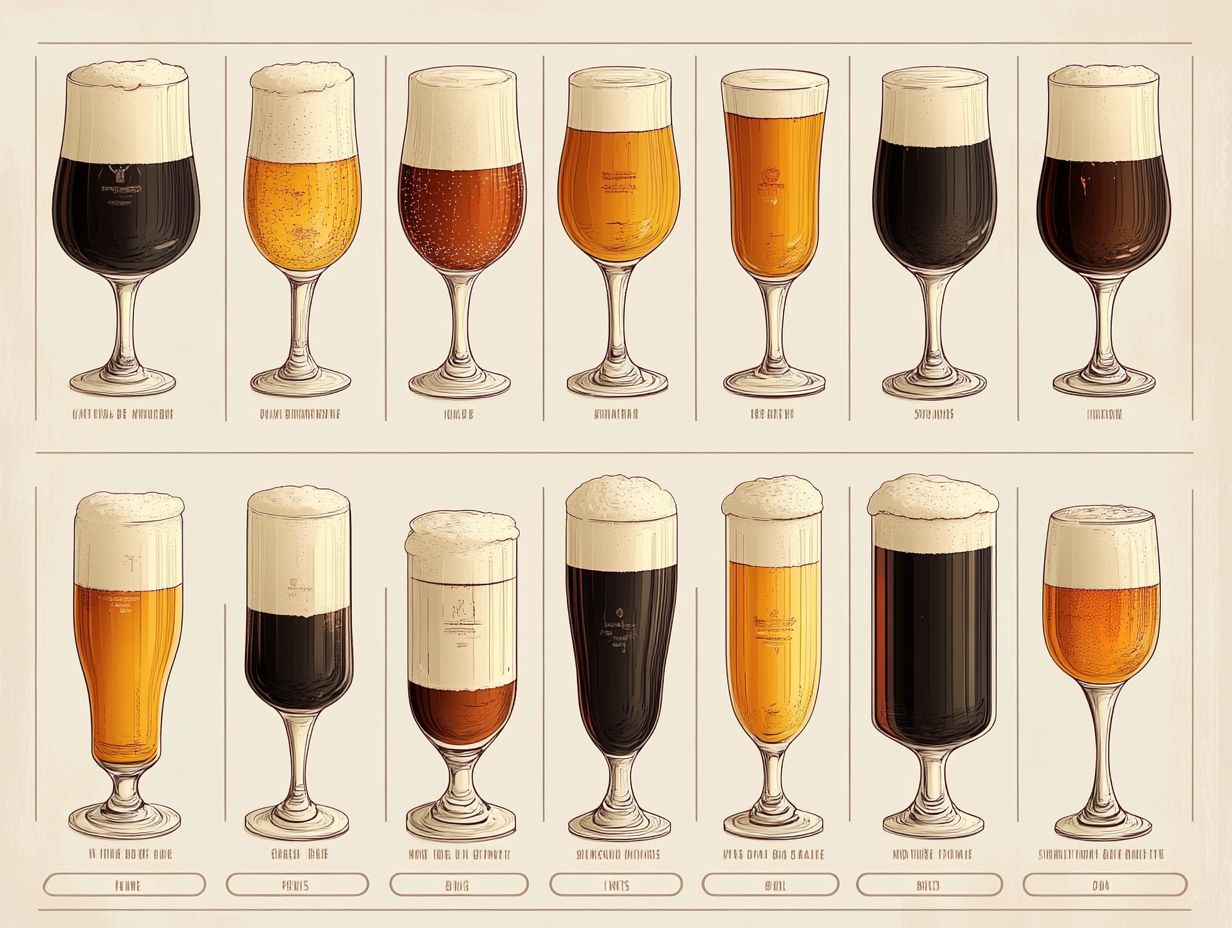
Stouts and porters reveal their true potential when enjoyed at slightly warmer temperatures of 50-55 F. This range allows their rich, complex flavors and aromas to fully flourish.
When you serve them at this optimal temperature, the deep roasted notes, along with hints of chocolate and coffee, come to life, offering you a more nuanced experience for your palate. You’ll find that the subtle sweetness and varying levels of bitterness enhance not just the taste but also the mouthfeel, delivering a velvety texture that beautifully complements each beer’s unique characteristics.
At these temperatures, you’ll be able to appreciate the intricacies of the hops and malt profiles essential components of both stouts and porters that take you on a satisfying and layered tasting journey.
What are the Best Temperatures for Pilsners?
Pilsners shine brightest when served between 38-45 F, delivering a refreshing experience that highlights their crispness and balanced bitterness. This specific temperature range is essential, as it allows the beer to retain its bubbly texture, ensuring that each sip unveils the subtle aromas and flavors unique to the style.
Serving a pilsner too warm risks flattening its lively texture, robbing you of the refreshing qualities that make it so appealing. On the flip side, if it s served too cold, you might miss out on the delicate hop notes and malt sweetness that contribute to a truly enjoyable experience.
By embracing this optimal temperature range, you can fully savor the harmonious blend of floral, herbal, and biscuity flavors that a well-crafted pilsner offers. Don’t miss out on fully enjoying your pilsner; serve it at the right temperature!
This makes it the perfect companion for warm days and relaxed gatherings.
What are the Best Temperatures for Wheat Beers?
Wheat beers are best enjoyed at temperatures between 45-50 F, a range that allows their light, refreshing flavors and soft mouthfeel to truly shine. This recommended serving temperature ensures you capture the essence of the beer’s character and brewing craftsmanship.
Serving these brews at the right temperature is key; it enhances their zesty and fruity notes while delivering a delightful crispness that satisfies your thirst. When poured within this optimal range, you ll find the subtle aromas of coriander and citrus come alive, making each sip refreshing.
Going too cold can sometimes mask the intricate flavors of wheat beers, which is why sticking to this temperature range helps you fully appreciate their unique character and ingredients. So, whether you re indulging in a hefeweizen or a witbier, letting them reach this sweet spot will undoubtedly elevate your tasting journey.
What Are the Best Temperatures for Sour Beers?
Sour beers reveal their true potential when served slightly warmer, around 50-55 F. This temperature allows the complex fermentation flavors and tartness to flourish fully. Craft beers truly shine at this temperature, revealing exciting flavors!
Within this range, you ll discover the modern nuances that these brews have to offer, showcasing the fruity and funky characteristics that arise from wild yeast and bacteria. As the beer warms, you might notice the acidity intensifying and the subtle aromas becoming more pronounced. It s common for enthusiasts to detect hints of citrus, apple, or even vinegar, all of which become more vibrant as the temperature rises.
By embracing this serving suggestion, you can genuinely appreciate the delicate balance of sweetness and sourness that defines exceptional sour ales, enhancing your overall enjoyment.
Tips for Controlling Temperature During Brewing
Controlling the temperature during the brewing process is crucial for achieving the beer characteristics you desire. For homebrew enthusiasts, this is particularly important. There are several effective tips and techniques you can employ to maintain optimal conditions.
A vital aspect of this endeavor is selecting the right equipment, such as temperature-controlled fermentation chambers and cooling systems. These tools help you regulate the brewing environment precisely. Understanding the nuances of fermentation, including the use of Kveik yeast a traditional Norwegian yeast known for its high fermentation temperature tolerance can greatly enhance the quality of your final product.
What Equipment Is Needed to Control Temperature?
To achieve effective temperature control in your brewing endeavors, essential equipment such as fermentation chambers, temperature probes, and specialized cooling systems is paramount. Precise temperature regulation is vital for producing high-quality beer. It directly impacts both the fermentation rate and the flavor profile.
Fermentation chambers are particularly advantageous. They create a controlled environment that shields your beer from external temperature fluctuations. Meanwhile, temperature probes provide real-time data, allowing you to monitor the fermentation process closely and make necessary adjustments. Cooling systems serve a critical function by swiftly lowering temperatures when required. This helps to prevent unwanted flavors and ensures the health of the yeast.
When you combine these tools, they facilitate a seamless brewing experience that leads to consistency and excellence in your final product. Breweries like Lowercase Brewing in Seattle can attest to the importance of temperature control in crafting exceptional beer.
What Are the Best Practices for Controlling Temperature in Brewing?
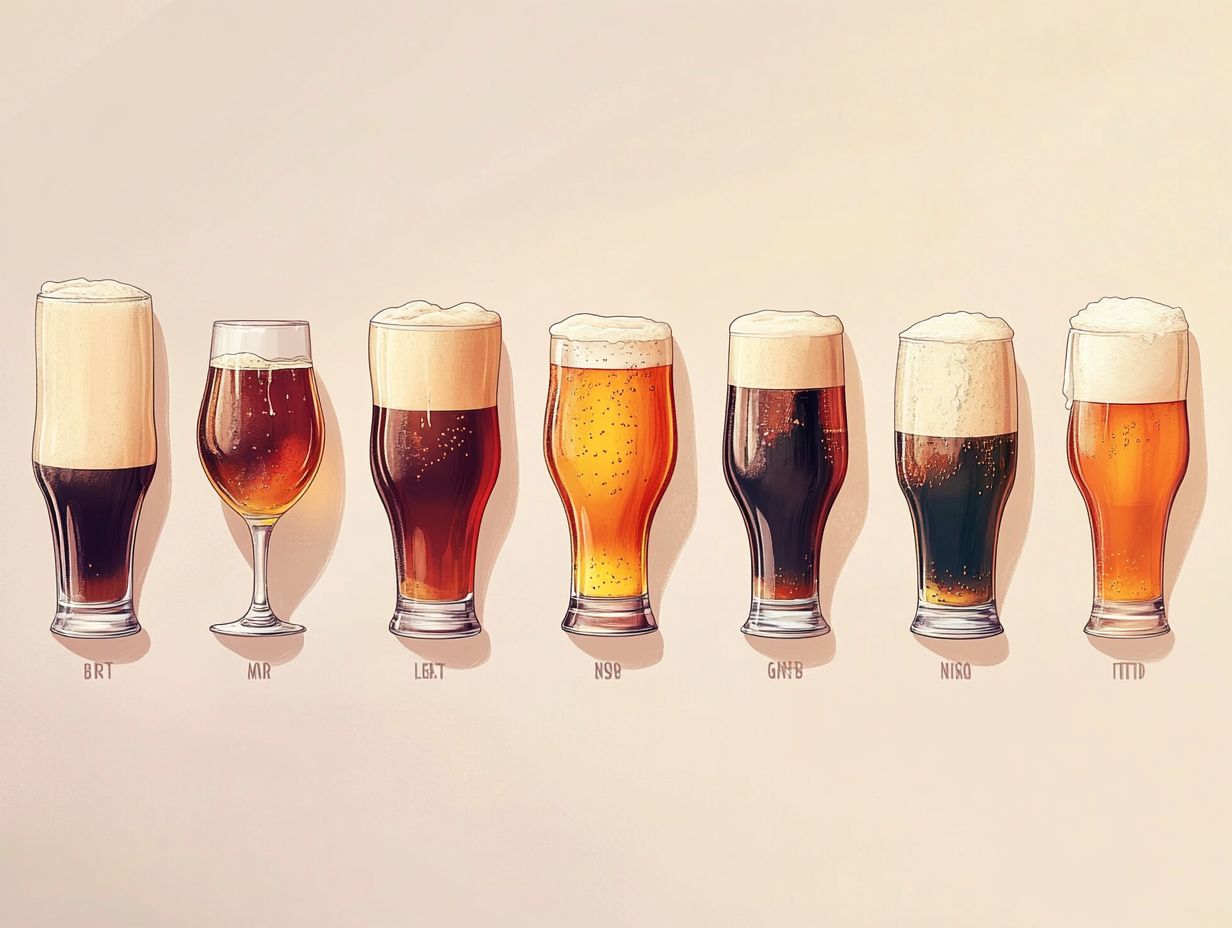
To control temperature effectively during brewing, it s essential to monitor fermentation temperatures closely, utilize insulated fermentation vessels, and adjust room temperatures as necessary to maintain consistent conditions. Understanding the role of temperature in brewing can also help in producing better homebrew.
Mastering these techniques not only optimizes yeast activity but also elevates the overall flavor profile of your final product. By employing a thermometer or temperature probe, you can obtain accurate readings during critical phases, ensuring that the yeast operates within its ideal range. Circulating cool water around fermentation tanks is another savvy move. This prevents heat buildup and enhances efficiency, especially for those brewing strong beers, which often require more precise temperature control.
Implementing these methods will significantly improve the beer s aroma, taste, and mouthfeel, leading to a higher quality brew. Each of these techniques plays a crucial role in crafting specific styles of beer, including ales, lagers, stouts, and porters. By mastering these techniques, you’ll not only craft exceptional beers but also elevate your brewing journey to new heights!
We encourage you to share your brewing experiences or ask questions in the comments below. Happy brewing!
What are the Common Mistakes to Avoid in Temperature Control?
When you’re controlling temperature during brewing, it’s essential to steer clear of common mistakes like neglecting to monitor temperatures regularly and overlooking ambient temperature changes. Additionally, avoid relying on inadequate equipment that struggles to maintain consistent conditions.
These oversights can lead to off-flavors, bitterness, and a noticeable decline in the quality of your final product. Many brewers underestimate the critical role that precise temperature control plays in fermentation rates and the overall beer profile.
To address these challenges, it s vital for you to invest in reliable thermometer devices, such as digital thermometers or wireless temperature monitoring systems. Creating a controlled brewing environment will help you manage the effects of external temperature fluctuations effectively. This is particularly important for maintaining the optimal temperature for different beer styles, whether you’re brewing homebrew or crafting brews at larger breweries.
Regularly check and adjust your tools and document temperature readings throughout the brewing process to ensure that you achieve the desired flavors, aromas, and characteristics. This practice will help keep unwanted surprises at bay.
Frequently Asked Questions for Brewing and Serving Beer
What are the benefits of brewing beer at specific temperature ranges?
Brewing beer at specific temperature ranges helps to achieve desired flavors, aromas, and alcohol levels in the final product. It also helps control the growth of yeast during the brewing process. This guide assists brewers in following the recommended practices for superior results.
What is the best temperature range for brewing ales?
The best temperature range for brewing ales is between 60-70 F (16-21 C). This allows the yeast to ferment at a moderate pace, resulting in a well-balanced and flavorful beer with optimal mouthfeel.
Can I brew lagers at the same temperature range as ales?
No, lagers require a lower temperature range of 45-55 F (7-13 C) for fermentation. This allows for a slower, cooler fermentation process that results in a crisp and clean tasting beer, in contrast to ales, which ferment at warmer temperatures.
What happens if I brew ales at a lower temperature range?
Brewing ales at a lower temperature range can result in a slower fermentation process and a less flavorful beer with a weaker mouthfeel. The yeast may become inactive, leading to incomplete fermentation and an undercarbonated beer.
How does temperature affect the different stages of the brewing process?
Temperature plays a critical role in each stage of the brewing process. It affects the extraction of sugars from the grains, the activity of yeast during fermentation, and the flavor development of the final product. Ensuring the temperature is optimal for each stage can enhance the bitterness or warmth of the beer, depending on your desired outcomes.
What is the ideal temperature for storing and serving beer?
The ideal temperature for storing beer is between 38-55 F (3-13 C). For serving, ales are best served at 45-50 F (7-10 C) and lagers at 40-45 F (4-7 C) for optimal flavor and carbonation. Some beers, like stouts and porters, can be enjoyed at room temperature or slightly chilled to better appreciate their complex nuances and characteristics.

